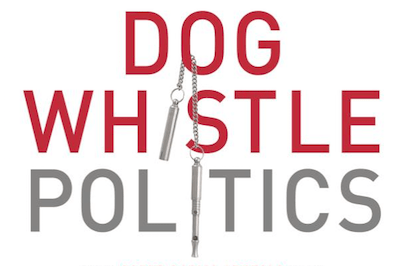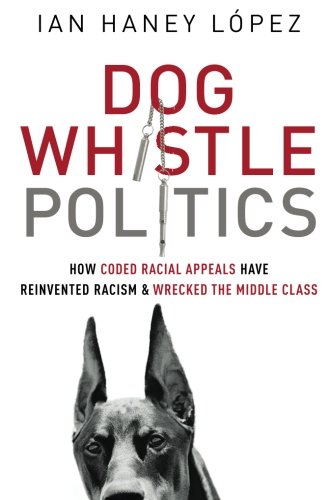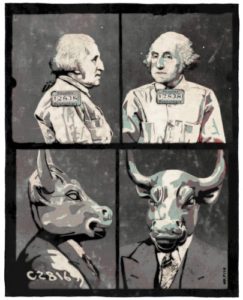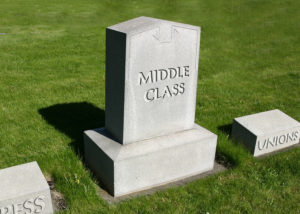Dog Whistle Politics
Ian Haney Lopez, the book's author, writes that many white Americans no longer see themselves as racist. He maintains, however, these people are manipulated by dog whistle politics -- coded racial language that "operates on two levels: inaudible and easily denied in one range, yet stimulating strong reactions in another."
“Dog Whistle Politics: How Coded Racial Appeals Have Reinvented Racism and Wrecked the Middle Class” A book by Ian Haney Lopez To see long excerpts from “Dog Whistle Politics” at Google Books, click here.
Ian Haney Lopez’s “Dog Whistle Politics: How Coded Racial Appeals Have Reinvented Racism and Wrecked the Middle Class” is as difficult to hold up as it is to put down. Not because of pounds of pages, but because it is another important book about race in America whose subject continues to be timely, and whose content is heavy and disheartening.
Across our land and beyond, recent racial history tests our collective self-image as a force-of-good nation. But then, our creation myth — with its cast of founding fathers who are quoted endlessly as marvels of ethical imagination, wisdom and humanity, fonts of high-minded political philosophy, and believers in liberty and justice for all — is a little skewed. What’s a few hundred years of hypocrisy, when the ideals are so admirable? Well, for one, if the origin story is slanted, what follows is not likely to be straightforward. A nation is bound to corrode if it refuses to confront — and teach — its truth, that it was built on and empowered economically by slavery and the not-quite-as-horrid history that followed for generations.
Lopez tells a decades-long tale of moral contradiction and corrosion, examining tactics that keep the scales unbalanced between whites and nonwhites — mostly blacks — in America. But his big idea is that racism has mutated substantially since the time before civil rights; and evolved racism has become a sneaky but significant tool in the breakdown of the middle class and liberalism itself. It used to be overtly brutal, debasing and exclusionary; it has transmuted into subtler, less obvious forms. The result is social havoc. Lopez’s thinking is original and complex, even if not all his writing and examples resonate fully.
Packed with history, this legal scholar’s work is one more indictment of the American system that passes for democracy. Viewed through the long lens of race, only those in deep denial refuse to see it as rigged rather than a republic. But that’s a lot of people. Lopez warns that our country’s future is threatened by a specific mechanism for reversing and limiting progress: dog whistling — the political tactic of using coded racial language that “operates on two levels: inaudible and easily denied in one range, yet stimulating strong reactions in another.”
He writes that most white Americans no longer see themselves as racist, nor do they consciously harbor hatred for nonwhites. Lopez believes that most who are susceptible to the luring tones of dog whistle politics are good people who are shocked by expressions of white supremacy. But he also argues that being basically good provides no immunity from the manipulative predations of those who use coded wording and storytelling to engrain negative stereotypes about minorities and achieve ideological goals. So, are we a land of decent fools?
Stretching back and forth in time, Lopez describes the ways ambitious politicians used race to manipulate voters, win elections and push policy once in office — often as repayment to their campaign funders. He outlines how coded communication began and continues to be adapted today. As a result, minority gains are minimized and white power is maximized. And he makes a case that it was largely through the use of these methods that support for social programs eroded.
According to Lopez, by linking crime and abuse of assistance programs like welfare and food stamps to blacks and other minorities, politicians — or “racial entrepreneurs” as he refers to them — subtly and steadily scared citizens to roll back government, and to vote against their own interests. The author notes that many whites who had supported New Deal safety nets began to turn against them in the late ’60s and early ’70s, when they became concerned that blacks and other minorities would be taking advantage of their benefits.The story starts with George Wallace, who was once a moderate on race — considering the times and his state of Alabama. With an NAACP endorsement, Wallace focused on issues like highways, schools and taxes in his first gubernatorial race and lost. He realized being soft on race was a liability; next time out, he campaigned as a redneck racist and won the office. Then, after blocking integration at the University of Alabama, a tsunami of support brought an epiphany: He understood that “the whole United States is Southern.” Wallace’s racist rhetoric at that point was too obvious to win the White House, though, so he became more suggestive of racial equality’s potential dangers by using coded language in his 1968 run.
Details of presidential candidates’ behavioral modification, from the ’60s to the present day, follow. Lopez charts the relative successes and failures of different politicians at manipulating race at election time. Goldwater fared badly, Nixon pretty well, and, Reagan best, in outcomes. However, Lopez underscores that every president since 1964 — including Democrats like Carter, Clinton and Obama — has used racial coding in some way in their campaigns because it was necessary to win. Reagan actually kicked off his 1980 campaign in Neshoba County, at a famous Ku Klux Klan lynching site, and somehow got away without much rebuke. So egregious a symbolic statement would not pass in a society that understood and repented its history.
With a cunning mix of optimism for the future and outrage for cheaters who siphon the future’s grand possibilities, Reagan conjured images of welfare queens driving Cadillacs and strapping bucks feasting on steaks while the rest of America sweated for their simpler suppers. That doesn’t sound subtle to me, nor did it at the time. Lopez maintains that the language used by Reagan was indirect and provided cover from accusations of racism.
From the Southern strategy to states’ rights, and welfare cheats to the food stamp president, the use and evolution of racial pandering is real. But how recognizable to the conscious mind is coding? How convincing is it to the unconscious mind? Many white people simply do not want to relinquish their privilege, and so respond to racial entreaties, like winks between knowing charlatans. As Bob Herbert wrote in the New York Times in 2007, “Everybody watching the 1980 campaign knew what Reagan was signaling at the fair. He was tapping out the code. It was understood that when politicians started chirping about ‘states’ rights’ to white people in places like Neshoba County they were saying that when it comes down to you and the blacks, we’re with you.”
(In a recent Rolling Stone interview, Lopez contends that 2015’s Republicans are not blatant racists, but dog whistlers, maneuvering their base unwittingly. Is this a form of diplomacy, to keep race in the media conversation? A worthy goal, but to pretend that the comments currently being spat across campaign venues are not overt — and outrageous — racism is confounding.)
Some politicians, like Wallace, and later Mitt Romney, never truly gathered national momentum. Is that because they couldn’t morph their personalities into the conjuring combo of slick and charming? Reagan’s ability to fool so many Americans about conservatism’s winner-take-most policies was at least partly due to his salesman-turned-actor skill at convincing people that he was a caring guy who couldn’t hurt anyone.
With his folksy but firm style, “the great communicator” undeniably guided swaths of Americans toward a mistrust of government and the belief that taxes are unfair, especially for corporations. Reagan had plenty of help reimagining the Fed as a till for the lazy “other” — from the increasingly consolidated media, the judiciary, and right-wing think tanks that publicized beliefs as facts. Lopez includes the big money and parallel powers that have worked in tandem with dog whistle politics and its coded linguistics. He provides many historical specifics regarding discriminatory housing loan policy and other institutional forces that have made it so difficult for black families to build even modest wealth in the U.S. If you cannot accrue wealth in a capitalist country, it’s difficult to build intergenerational stability; you certainly cannot gain power. But that correlation was and is little discussed in public.
As another example of dog whistling that avoided mentioning race directly, Lopez uses the Willie Horton ads from the Dukakis-Bush election. (The ads featured a mug shot of Horton, a black man convicted of murder who kidnapped a young white couple, stabbing the man and raping the woman when released on a weekend furlough, and jeered Dukakis for vetoing a measure to make murderers ineligible for “weekend prison passes.”) Citing Princeton politics professor Tali Mendelberg, who studied the public support for Bush 1, before and after the racial element was publicly aired in the media, Lopez states:
“Mendelberg found that support for Bush rose precipitously during the phase of the Horton campaign, and then plummeted sharply once [Jesse] Jackson shoved race to the surface. …This result strongly suggests that most of those who respond to dog whistles do not consciously hear them as racial appeals.”
There are subtler references to race in politics, but Horton’s mug shot, with the accusation that Dukakis’ policy would not protect his own wife, made pointed reference to race unnecessary. Did voters not see the ads as race baiting until Jackson decried them as such, or did they just not admit it? The Horton ads that fed white fears of black men were also part of a long-term process that racialized crime and increased prison sentences. America is barely beginning to address the ways in which it came to lead the world in incarceration and sentencing rates, with the numbers of black prisoners grossly out of proportion to their population ratio, and rate and type of crimes committed.
In his discussion of the Horton ads and throughout the book, Lopez uses terms that he introduced earlier as steps in the dog whistling process: “punch,” “parry” and “kick.” “Punch” refers to the injection of race in campaigns and politics, “parry” to feigning outrage over the accusations of the effort, and “kick” to using offense as defense by claiming the accuser is the real racist. The ploys are as recognizable as they are reprehensible, but the words chosen by Lopez lack association with the subject. The author’s lexicon would be more effective if less opaque and abstract.
One of Lopez’s strongest chapters covers the notion of societal colorblindness as a perceived attribute. Ironically, it grew out of advances made in the civil rights era. After key legislation outlawing discrimination was passed, many whites could not understand why blacks were still so far behind economically, when white European immigrants had managed to move ahead. Many blacks remained stuck in ghettos, unable to move into the middle class, so their mores and family lives became the target of establishment criticism in place of their skin color. Instead of pointing, logically, to long-term effects of institutional racism, the privileged determined that culture, not systemic causes, must be to blame. To this day, many whites conveniently and disingenuously insist they do not see race; they see worthy and unworthy, success and failure. (Stephen Colbert often skewered the absurdity of colorblindness on “The Colbert Report,” going so far as to ask guests their race.)
Later, Lopez recounts an experiment that public school teacher Jane Elliott tried right after Martin Luther King Jr. was shot, in order to demonstrate the experience of segregation and discrimination to her third-graders. For only three hours, on each of two days, Elliott separated the class by eye color, blue and brown, and took turns treating the two groups as inferiors. The results were profound, leaving the children humiliated, withdrawn and unsure in class. As Lopez writes, “Imagine the toll of a whole childhood facing belittling messages.” Yet, this failure of imagination and compassion continues. (Although not mentioned in “Dog Whistle Politics,” Elliott continued her experiment domestically and internationally for over 40 years. Over that time, it surprised and taught people of all ages, sometimes angering parents or adults who participated.) The growing numbers of poor and marginalized citizens continue to illustrate that a lack of racial and economic justice severely limits our country’s potential.
Lopez returns often to the subject of the folding middle class, and the need to revive a caring government that helps preserve civilized society. He emphasizes the centrality of dog whistling to the conservative movement’s success in diminishing social programs, because it feeds on fear and yet is deniable. Liberals have long been stumped as to why those who struggle economically vote against their own interests, and Lopez’s theory is among the more compelling. However, in a November 2015 New York Times op-ed called “Who Turned My Blue State Red?” Alec MacGillis argued our country lacks not for liberals who favor social programs, but voting liberals. Also supported by research, this is another stumper, especially in light of 2009 statistics Lopez cites, showing that over two-thirds of Americans — not just liberals — back government involvement in almost every social issue, from education to health care to jobs.
“Dog Whistle Politics” is a significant contribution to political and racial analysis, and the connections made by Lopez between soft racism and the hardening opposition to government are provocative. The implications of an ignorant and easily duped nation are also troubling. While not doubting the wily role of constant racial insinuations, I finished the book thinking that Lopez’s historical work makes a stronger case, perhaps inadvertently, that educational institutions still hold the cards with the most chance for change. Euphemisms could not sway the public if generations had not been taught half-truths and heraldic fictions as substitutes for shameful history. America cannot move beyond a past it doesn’t fully grasp.
Still, Lopez is wise to warn that racial division harms all members of society, and to insist that everyone take the uncomfortable steps to talk about race. But our schools must teach history honestly, well before college, to assure that children don’t grow up in a bubble of ideals that don’t match reality. Only then will it become difficult for the courts and owners of mass media to favor the financial elites — still mostly white — over justice and truth. Only then will the national conversations be smart enough to enable rebuilding our country into the place of its perennial promise.
Your support matters…Independent journalism is under threat and overshadowed by heavily funded mainstream media.
You can help level the playing field. Become a member.
Your tax-deductible contribution keeps us digging beneath the headlines to give you thought-provoking, investigative reporting and analysis that unearths what's really happening- without compromise.
Give today to support our courageous, independent journalists.







You need to be a supporter to comment.
There are currently no responses to this article.
Be the first to respond.